
Hardly a day passes without some sort of China news in the financial headlines. There’s a good reason, too. China is the global economy’s 600-pound gorilla, second in size only to the US. Yes, it was largely a copycat business economy up until the early 2000s, but Chinese entrepreneurs have really taken charge in the last 10 years. Fueled by the profits from huge consumer demand, they are expanding not only in China but globally. This story is largely ignored in the US and in much of Europe. We hear about a few projects here and there, but we don’t understand the extent.
China is on its way to becoming the largest economy in the world, which because of its population, it should be (possibly with the exception of India, if they ever get their act together). Short-term events and arguments sometimes obscure this longer-term reality. China’s transition from rural poverty to export powerhouse to consumer goliath may be the most consequential economic event in centuries. Possibly ever—I can’t think of a historical example to rival it. Historians might argue the British Empire or even the US from 1800–2000, but that took centuries. China has done it in a little over 30 years.
When I say “consequential,” I mean they can be either good or bad. We’ve seen both and will continue doing so. Along with Worth Wray, I wrote a 2015 anthology on China called A Great Leap Forward? So this is not my first deep-dive into China.
Even so, periodically I like to step back and assess where we are in this massive change, and that will be my focus for the next three letters. Today and next week, we’ll look at the bright side: The good things happening in China, much of which will help the rest of the world, too. Just like the work going on in the US and Europe and other countries is helping the rest of the world. Entrepreneurs and scientists inventing new ways for us to better our lives is good for everyone everywhere. Then the third letter will consider some darker possibilities. It is not all sweetness and light in China, as long-time readers know.
I could start by going through all the stats on how big China is, but they are so mind-boggling, we really can’t process them. In just one generation, something like 300 million+ people went from rural subsistence farming to urban industrial and technology jobs. Some of the cities in which many now work, didn’t exist when they were born. Hundreds of millions more are waiting in the wings to make that same journey or have already made a journey to “smaller” cities of just a few million people (note sarcasm).
I can find 13 cities with over a 10 million population in China. There are literally scores over 5 million. But that doesn’t tell the story. China is currently creating 19 “super city” clusters by strengthening the links between them. HSBC projects that 80% of Chinese GDP will come from those cities.
Last week, Financial Times reported Beijing plans to integrate former Western colonies Hong Kong and Macau with other nearby urban areas including Shenzhen and Guangzhou into this “Greater Bay Area.” Already, it accounts for 12% of Chinese GDP and 37% of the country’s exports. Beijing wants the GBA to lead the nation’s innovation and economic growth.
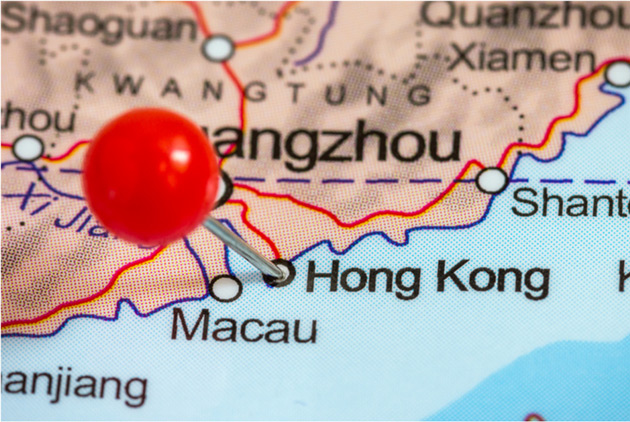
Photo: Getty Images
To that end, the government is pouring infrastructure investment into the region, including a 22-mile bridge connecting Hong Kong and Macau (not cheap!) with the mainland and a new $11 billion rail link for Hong Kong. It also plans to eliminate some of the bureaucratic barriers that presently slow down commerce.
“The GBA is home to a high concentration of dynamic private businesses, such as Tencent, Midea, and Huawei. It is also China’s most innovative urban cluster, generating more than 50% of the country’s international patent applications. And, according to HSBC, the GBA is the least burdened by inefficient state-owned enterprises and excess capacity.
“The reason is simple: The GBA is far more market-oriented than its counterparts, with Hong Kong and Macau much more open to the outside world than any other Chinese cities. Both cities not only permit the freer flow of goods, services, capital, technology, talent, and resources, but also meet global standards in terms of regulations, business practices, soft infrastructure, and even lifestyles.”
(Source: Andrew Sheng and Xiao Geng, Project Syndicate)
Part of this area is Shenzen, just north of Hong Kong.
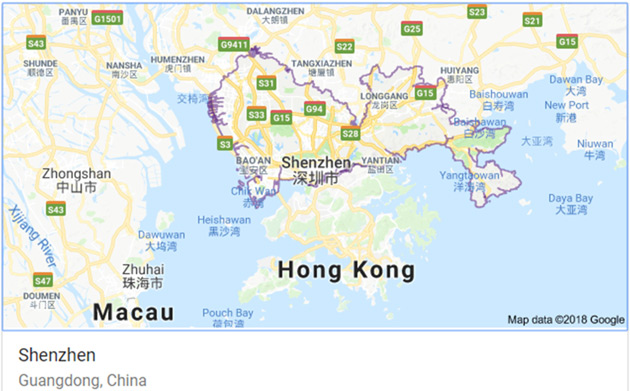
Image: Google Maps
In 1980, Shenzhen was a fishing village of 30,000 people. Today, it produces 90% of the world’s electronics and is home to over 12.5 million people. It has 3 million registered businesses. It is compounding its growth at over 12% a year, doubling in the last six years.
The size of this region is hard to comprehend. With nearly 70 million people and $1.5 trillion GDP, it is economically bigger than Australia or Mexico. Guangdong (the mainland China part) alone exported $670 billion in goods last year. Three of the world’s ten busiest container ports are in the region. It will be Silicon Valley on steroids.
For that matter, it could be the US on steroids, at least geographically. From Hong Kong you can fly to Singapore, Kuala Lumpur, Bangkok, Manila, Shanghai, Seoul, and Tokyo as fast as I can get from Dallas to San Francisco. This Greater Bay Area will be the center of the world’s fastest-growing region, with billions of smart business people, scientists, and consumers.
According to Wealth-X, Hong Kong just overtook New York as the world’s largest concentration of ultra-wealthy people (net worth of $30 million or more). Their study specifically attributes it to enhanced links with mainland China. Look for this to continue.
Research Capital
When Americans import Chinese goods, we get stuff we want and China gets our US dollars to spend. Ditto for China’s other customers. They receive goods, China receives cash. On this end, much of what we purchase ends up in landfills, or like our iPhones, being replaced every few years. Not so over there. They often spend our cash more wisely than we use their doodads. (Infrastructure is a good example. Many Chinese highways, railroads, and airports are far superior to ours.)
This is a great chart on the world’s top exporters in 2017. While you can easily see that China out-exports the US, I find it interesting that Germany is almost the size of the US, and that the Netherlands, with only 17 million people (barely 5% of the US population), exports $652 billion. On an export dollar per population, why isn’t the US worried about the Netherlands?
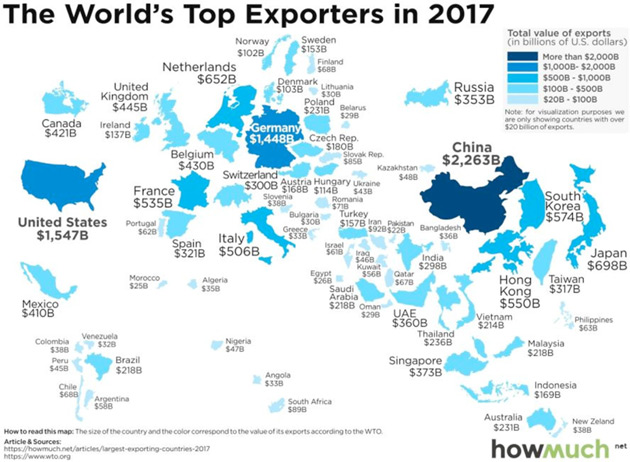
Image: Visual Capitalist (Click to enlarge)
Beijing sees this same data and realizes its leadership is not guaranteed. China needs to develop its own technology, and doing so requires research, and research requires capital. So, through a combination of government edicts and profit-seeking, it is right now in a major effort to build its own innovation economy.
The plan isn’t complicated. To summarize, “Throw money at it.” Beijing is forcing money into venture capital at an astonishing pace. My friend Peter Diamandis toted up the numbers last month.
By end of 2017, 3,418 Chinese VC funds were launched within the year, raising a combined $243 billion USD or 1.61 trillion RMB.
Of the $154 billion worth of VC invested in 2017, 40 percent came from Asian (primarily Chinese) VCs. America’s share? Only 4 percentage points higher at 44 percent.
In the first three quarters of 2017, 493 state-backed funds were founded with a capital size of 114 billion USD (756.8 billion RMB).
And as of two years earlier, Chinese VC coffers had surpassed a remarkable $336.4 billion USD.
In a great push to scoop up intellectual property and drive growth in key tech sectors, China’s VC scene is booming.
As of 2016—before the numbers Peter lists there—China VC investment had roughly caught up to US level. Now it is probably ahead.
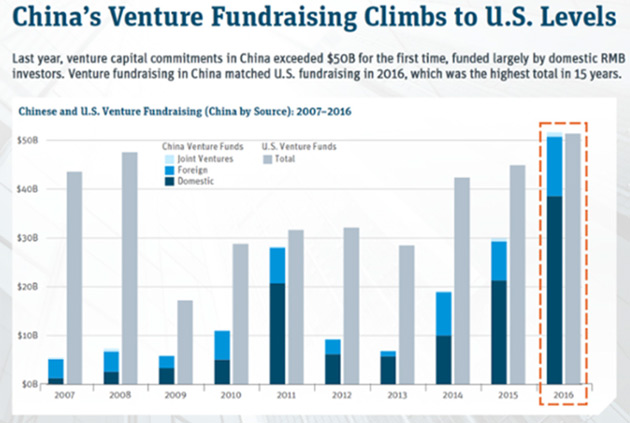
Image: VentureBeat
Of course, merely spending money isn’t the same as spending it wisely, nor does it mean the resulting products will succeed. But the research is the first step, without which little is likely to happen. AI doesn’t invent itself (yet).
Peter Diamandis says Chinese VC firms are targeting three segments: robotics, driverless vehicles, and biotechnology. I can see why, too: demographic necessity. It’s odd to imagine labor shortages in such a huge country, but that is a growing problem for China. Decades of the one-child policy produced a severe age imbalance. Robotics and driverless vehicles will address that problem, while biotechnology may help China avoid the healthcare spending that weighs down the US economy.
Yet this is good news for the whole world. Chinese innovation in these segments won’t stay in China. They will export it and, if it’s better than what others produce, the market will let everyone benefit. So, I hope they go full speed ahead. May the better tech win. (Of course, I will still root for the home team!)
Paper Wars
It is common knowledge that China has produced more scientists and engineers for decades than the West has combined. Many of us had suspicions about the qualities of the universities and their degrees. They couldn’t be as good as ours, could they? Well, we’re beginning to see the answer to that, and it turns out they were comparable and possibly even better in some areas.
As a graphic indication, here’s the countries with the most STEM graduates:
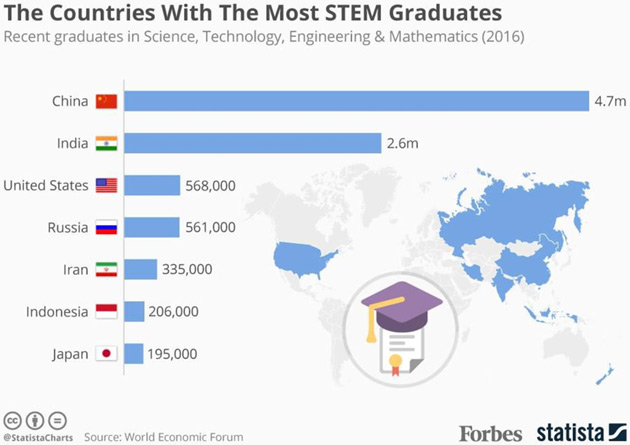
Image: Forbes
We know China’s contribution to scientific knowledge has grown, but how much so is less clear. Exactly what counts as “Chinese” research? You have Chinese people working both within China and in other countries, including at many top US and European universities. How do we categorize their contributions? It’s hard to assess.
A recent study gives us new data. Last month, Quartz cited a study by Qingnan Xie of Nanjing University and Richard Freeman of the National Bureau of Economic Research, which looked at the number of scientific papers with Chinese authors. Unlike other such studies, they included not just authors in China, but those with Chinese names but located elsewhere.
That’s an imperfect standard, of course. You can have a Chinese name and live in Singapore. Many US citizens have Chinese surnames, and the Chinese diaspora is well known. Likewise, not all research by ethnically Chinese researchers will find its way back to Chinese businesses or government agencies, nor is every paper an equally valuable contribution to the world’s knowledge base. But the study seems as rigorous as possible, so I think the general findings are probably right, at least in their direction.
Xie and Freeman found that in 2016, roughly 24% of scientific papers had an author with a Chinese name or address. If you include Chinese-language papers, it jumps to 37%.
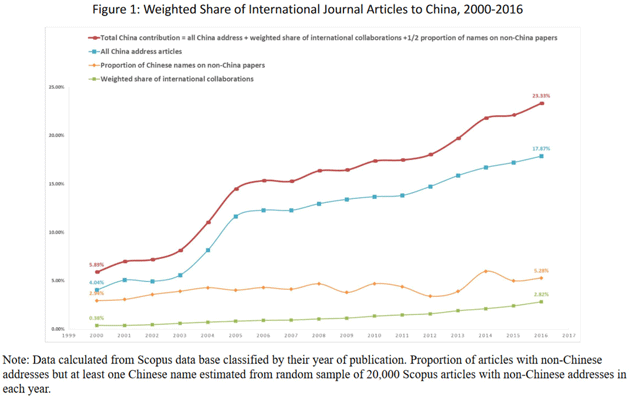
Image: NBER
Looking at it another way, China has 15% of global GDP but produces more than a third of the scientific papers. It seems those university degrees are beginning to pay off in actual research.
Again, we’re not considering the value of those papers. Some may be worthless. But just in terms of output volume, China is producing far more research than its share of the world economy and population says it should. As the chart shows, this figure has been trending steadily higher, too.
Now, recognize how breakthroughs happen. They are often a consequence of large numbers. The more smart people you have trying to solve a problem, the more likely one of them is to solve it. Most will fail and that’s ok. All you need is one success.
If China has more scientists working on more problems than anyone else—and it does—then we can expect China to find more solutions, other things being equal.
As I said, this is okay from a global perspective because we will all get the benefit of those breakthroughs. But we won’t get it free, and the price will be higher for us in the US if we have to import it from China.
So, this is not a race the US or Europe or the West or anyone should concede, but we are conceding it in some ways. For instance, when we admit Chinese students to study at our top universities then don’t let them stay here to build their careers. We educate them and send them back. It makes no sense. We should give them a green card and an open door. You think they are taking jobs? No, they are creating jobs in China when they could be creating jobs here. Just saying…
A Place to Innovate
Matt Ridley says human progress and prosperity make the greatest leaps when “ideas have sex with each other.” They produce offspring, in other words. This creative process happens faster and more easily when the idea-holders share proximity. Many inventions come from large cities not because city folk are any smarter, but because the necessary mix of ideas was in the same place, at the same time. In the US, Silicon Valley often serves this purpose. Along with Austin, Dallas, Boston, New York, and others.
China has abundant venture capital to fund research and large numbers of researchers cranking out ideas. It needs a central place for those ideas to have frequent sex with each other. The government is aware of this and, in true command-economy style, has decreed it will happen in the Greater Bay Area I mentioned above.
Economic growth is largely a numbers game: workers times productivity. China already has both ingredients and is working assiduously to enhance them further. For now, the US is still ahead, but we shouldn’t be complacent. Nothing requires the global economy to keep us in the lead, and we are not doing what we should to keep it.
There are literally books written on this. Everywhere you turn is an amazing story. Many readers are going, “Okay, China has a lot of large cities and fast trains. So what?” Serious research shows that creativity goes up the larger the city gets, measured in either new businesses or GDP or patents. Putting humans together has been a spark for new ideas since man first began to organize cities 10,000 years ago.
But large cities are not the real story. China is shifting from an export-driven to a consumer-driven economy. That will be a rough transition in itself, but the government is leaving little to chance. Here in the US, we’re skeptical of central planning. I certainly am. But I have to admit, if it’s possible for a centrally planned economy to achieve sustainable long-term growth, China will be the one to do it.
And again, there is decades old accepted economic research to demonstrate that a centrally planned economy has some advantages in the early stages of development. The transition to a consumer-oriented society is the most difficult for a top down, centrally planned economy to manage. So far, China seems to be letting entrepreneurs put capital to work without having to tell them how to do it. They just give them the tools and, sometimes, the money as well.
Next week, we will look at some even more astounding data, then later go on to what could cause China to stumble. Remember those 1980s predictions Japan would own the world? It turns out you can only do so much on credit. Stay tuned.
*This is an article from Thoughts from the Frontline, John Mauldin's free weekly investment and economic newsletter. This article first appeared here and is used by interest.co.nz with permission.
21 Comments
Its called GROUP THINK .
Quite simply the media is controlled, the State outlines the narrative and it tells you what to think and do , and everyone buys into the narrative .
I have never been able to understand how an intelligent community of China's size seldom questions the central planning , and lack of robust debate .
I've wondered the same about NZ for decades.
:)
Agreed, but I do think that the invisible hand that controls the mainstream media is starting to become exposed in New Zealand
Not starting, it gets silly at times.
My favorite from yesterday was a Stuff headline that stated something like "NFL player dies after going hunting with Donald Trump Jr", with a similar headline in the NY Post.
Turns out that he went hunting with the Donald Jr a month and a half prior to committing suicide due to issues about severe brain damage from getting his head banged about repeatedly during his NFL days. He founded a rather successful hunting apparel company so the hunting thing wasn't totally unexpected. Hunting with the Donald Jr is only noteworthy in a very tertiary sense, but it makes for a salacious headline. As so many people read primarily headlines without actually reading any underlying article (far less, researching the data), the headline serves the purpose of manipulating the public opinion.
(fair disclosure, I'm very much not a fan of the Donald, but am also not a fan of the media treatment of him)
Do they do this deliberately I wonder? Or is it a case of not realizing they are doing something fundamentally wrong? Either way some time spent in a re-education camp could correct this behaviour.
Seriously though the dangers of manipulation by the mass media should be a compulsory class in all our schools. It certainly should be the job of all parents to teach their children to be aware of manipulation.
Having watched for decades how the supporters of any [major] political party you care to mention act I cant see any difference.
Scarily the Chinese have only one party so its Group Think needs to be right all the time. And having watched our political parties for decades, can you ever remember any of them being consistently right?
Boatman,
"Lack of robust debate' might just have something to do with there not being a free press. Eg. try googling Tianenman Square while in China. Dissidents are regularly sent to prison or education camps. It is not a democratic society.
I suggest you read some books. Try China's great Wall of Debt or China's Crisis of Success or The Devouring Dragon.
We are heading that way too. Have you seen the likes of CNN dismissing Wikileaks? What about YouTube banning Alex Jones. What about Facebook censoring everything.
There is not enough resources left in the world for China to outgrow the USA. The two will be at war at some point over the dwindling reserves.
The reason China has been able to grow so fast you would really put down to exponential growth in oil. They have been able to ride on the back of all the infrastructure put in place by earlier economic powerhouses. However they are late to the party, it is a downhill slide from here.
Yep - China is too late to the game, there aren't enough pieces left on the board, and she'll have to go to war.
India didn't get to the start-line.
However both India and her favourite "playmate" have big boy toys.
The game is not being played with a 2 dimensional board.
https://www.yicaiglobal.com/news/china-shoots-stars-plans-build-space-e…
The China story has been both fascinating and scary to watch now for some two decades or more.
When we (NZ) started importing them after the 1987 share market crash, I said to anyone who would listen..."Do you realise how many of them there are?" All I got was blank stares or silence.
Since then I've been quite verbal about the 'Dragon waking up' and look out when she breathes fire. You then know what I have been called, don't you?
This has been both predicted and is now a reality for the whole planet to ponder, not just us. It's their leadership that concerns me most. They are brutal and efficient and even clever. As the article says, It's a numbers game and they have the numbers. The sooner the southern regions split from the northern control centre the better. There's actually about 15 or more 'countries' within China all with their different languages and cultures, not that they'd tell you that. If we really want to slow it down, split them up.
They also believe it is their destiny to rule the planet. And from what I know and from what we read and hear, you could be forgiven for believing that. They are bloody hard workers with an outstanding ability to be smarter than the people who are teaching them (US).
So, where does that leave us? Sadly, between a rock and a hard place. Our birth control is now beginning to haunt our culture. We are not enough any more. The rest of the world is populated to within an inch of its life. There is not enough room for everybody. Sorry, but there's not. The planet's end game has begun. And in many ways, thank goodness for that. Living under & reporting to Beijing frightens me. And many others, believe me. They already have our business. We are addicted already.
This doesn't end well I'm afraid.
At least two of those countries are apparently under what amounts to martial law, with at least a million in concentration camps to boot.
https://www.independent.co.uk/news/world/asia/china-re-education-muslim…
Better to "re-educate" them and get rid of that fifth column sooner than end up like Sweden with huge crime problems.
Did you read that link? Dreadful but somehow this is the bit that bothered me most - even more than the beatings and the torture:
""In a June 2017 paper published by a state-run journal, a researcher from Xinjiang’s Communist Party School reported that most of 588 surveyed participants did not know what they had done wrong when they were sent to re-education. But by the time they were released, nearly all – 98.8 percent– had learned their mistakes, the paper said.""
The UK does similar things, just on a smaller scale. Mass surveillance, informers, arrests, interrogation, torture and imprisonment for "wrongthink". Most of the population think this is okay.
My father, who died in 1975, used to say, "If America and Russia went to war, China would be the winner". Clearly, back then, the most likely scenario, should a major war break out, would begin with the US and Russia, but somehow or other he saw China as the real threat.
When you think about it this has already happened. China was treated like a charity case by the US during the Cold War. Nixon bolstered China to counter the USSR. When Nixon came to power the Chinese and the Russians were actually having armed clashes at points along their common border.
The Dutch export figures seem extraordinarily high translating to $38,000 per person compared to NZ's $8,085 per person and China's $1,640 per person. I guess it doesn't really mean a lot if you are importing more than you are exporting or if you import stuff and then export it again. A more interesting chart would be the balance of trade and trade surpluses.
Germany - https://tradingeconomics.com/germany/balance-of-trade
US - https://tradingeconomics.com/united-states/balance-of-trade
China - https://tradingeconomics.com/china/balance-of-trade
NZ - https://tradingeconomics.com/new-zealand/balance-of-trade
Netherlands - https://tradingeconomics.com/netherlands/balance-of-trade

We welcome your comments below. If you are not already registered, please register to comment.
Remember we welcome robust, respectful and insightful debate. We don't welcome abusive or defamatory comments and will de-register those repeatedly making such comments. Our current comment policy is here.